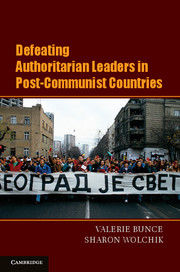Book contents
- Frontmatter
- Contents
- List of Figures and Tables
- Acknowledgments
- PART I THE PUZZLE
- PART II CASE STUDIES
- PART III COMPARATIVE ANALYSES
- 8 Explaining Divergent Electoral Outcomes
- 9 The Electoral Model
- 10 The Cross-National Diffusion of Democratizing Elections
- 11 After the Elections
- 12 Conclusions
- Appendix
- Index
11 - After the Elections
Explaining Divergent Regime Trajectories
Published online by Cambridge University Press: 05 June 2012
- Frontmatter
- Contents
- List of Figures and Tables
- Acknowledgments
- PART I THE PUZZLE
- PART II CASE STUDIES
- PART III COMPARATIVE ANALYSES
- 8 Explaining Divergent Electoral Outcomes
- 9 The Electoral Model
- 10 The Cross-National Diffusion of Democratizing Elections
- 11 After the Elections
- 12 Conclusions
- Appendix
- Index
Summary
You go to democracy with the country you have, not the one you wish you had.
Thomas FriedmanThese breakthrough elections in the postcommunist region were not just important in and of themselves; they were also the beginning of a longer-term process of democratization through institutional change.
Kenneth WollackIn the previous chapters, the puzzle of interest was explaining variations in electoral outcomes in mixed regimes located in postcommunist Europe and Eurasia. As we discovered, the contrast between the norm in mixed polities – that is, continuity in authoritarian rule – and the exception – that is, electoral victories by the opposition – reflected the extent to which oppositions and their allies were willing and able to implement a set of innovative electoral strategies that made them far more effective at winning power. Although struggles between oppositions and regimes in each country played a role in this process, so did international diffusion – in devising, implementing, and transferring this model of winning power.
This chapter shifts our attention from the causes of electoral stability and change to the consequences. Our interest, therefore, is in treating these elections not as a dependent variable, but rather as an independent one. Put simply: how much of a difference did these elections make? We address this issue by carrying out two types of comparisons that focus on political and economic developments after the elections: among the countries where electoral breakthroughs took place, and between this group of elections and those where oppositions failed to win power.
- Type
- Chapter
- Information
- Defeating Authoritarian Leaders in Postcommunist Countries , pp. 307 - 326Publisher: Cambridge University PressPrint publication year: 2011

